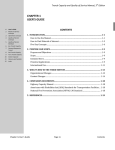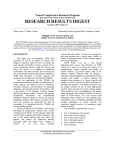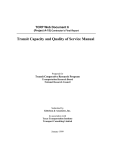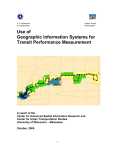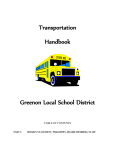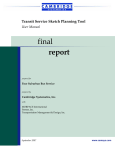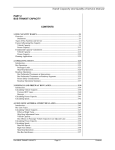Download Demand-Responsive Transit - Transportation Research Board
Transcript
Transit Capacity and Quality of Service Manual, 3rd Edition CHAPTER 7 DEMAND-RESPONSIVE TRANSIT 1. User's Guide 2. Mode and Service Concepts 3. Operations Concepts 4. Quality of Service Concepts 5. Quality of Service Methods CONTENTS 1. INTRODUCTION ........................................................................................................................7-1 How to Use This Chapter ................................................................................................................... 7-1 Other Resources .................................................................................................................................... 7-1 6. Bus Transit Capacity 2. DRT CAPACIT¥..........................................................................................................................7-3 7. Demand-Responsive Transit Capacity Factors .................................................................................................................................... 7-3 8. Rail Transit Capacity Capacity Calculation Procedures ................................................................................................... 7-6 9. Ferry Transit Capacity 10. Station Capacity 11. Glossary and Symbols 12. Index Importance of Ridership Demand for Estimating DRT Capacity ...................................... 7-8 3. REFERENCES ........................................................................................................................... 7-10 I Chapter 7/Demand-Responsive Transit Page 7-i Contents Transit Capacity and Quality of Service Manual, 3'd Edition 1. INTRODUCTION Transit capacity deals with the movement of people and vehicles, depends on the size of the transit vehicles and how often the vehicles operate, reflects the interaction between passenger concentrations and vehicle flow, and reflects operating policies of the transit service provider. For bus transit, capacity must specifically address bus routes, bus lanes, and bus terminals in terms of persons carried. In short, it is a complex topic. DRT capacity addresses how many vehicles and service hours are needed to serve a given passenger demand and service area. Demand-responsive transit (DRT) capacity is also complex but it is a different proposition than bus capacity. For DRT, the issues relate to how many vehicles and vehicle service hours are required to accommodate a given passenger demand and service area. Similarly to bus transit, DRT capacity also depends on vehicle size and the operating policies of the DRT service provider, such as the length of the on-time window. DRT capacity may also depend on the provider's policy regarding how much capacity to deploy. This, in turn, may relate to available funding or other local circumstances. Chapter 7 of the Transit Capacity and Quality of Service Manual summarizes the state of knowledge regarding DRT capacity and ridership demand (Section 2) and provides a list of references used in developing the chapter (Section 3). HOW TO USE THIS CHAPTER Chapter 7 is short, covering the following three topics: • The "Capacity Factors" section describes the factors specific to DRT that influence the available capacity. This section provides a good introduction to DRT operating issues for those new to planning, operating, or studying DRT service. • The "Capacity Calculation Procedures" section describes different techniques that are available for estimating DRT capacity, depending on DRT system characteristics and available data. No computational methods are provided; instead, readers are referred to other sources for guidance on implementing the methods. • Although the TCQSM is not a ridership estimation tool, DRT ridership demand is a key factor for estimating DRT capacity. Therefore, an "Importance of Ridership Demand" section is provided that summarizes the contents of four TCRP reports and documents on the subject, links to which are provided in full on the accompanying CD-ROM. OTHER RESOURCES Other TCQSM material related to DRT includes: • The "What's New" section of Chapter 1, User's Guide, which describes the changes made in this chapter from the 2nd Edition. • Chapter 2, Mode and Service Concepts, which summarizes the development of DRT as a transit mode, highlights the different types of DRT service, and gives Chapter 7/Demand-Responsive Transit Page 7-1 Introduction I Transit Capacity and Quality of Service Manual, 3'd Edition typical ranges of productivities for those services, and describes the different DRT service patterns in use. • Chapter 5, Quality of Service Methods, which includes a section on evaluating the quality of DRT service. • The TCQSM's CD-ROM, which includes links to electronic versions of all of the TCRP reports referenced in this chapter. Introduction Page 7-2 Chapter 7/Demand-Responsive Transit Transit Capacity and Quality of Service Manual, 3'd Edition 2. DRT CAPACITY CAPACITY FACTORS DRT passengers are generally provided a seat, unlike fixed-route service where standees may increase vehicle capacity. For most types of DRT service with a dispersion of origins and destinations, the number of vehicles and vehicle service hours required is dependent on a number of factors, including ridership demand, passenger characteristics, peak-period demand, service area size and characteristics (e.g., railroad crossings, topographic features, traffic congestion), DRT trip pattern (e.g., many-to-many, many-to-few), and service policies that affect DRT operations. Generally, DRT passengers are provided a seat for service, unlike fixed-route service where standees may increase vehicle capacity. Ridership Demand Ridership demand is one of the most important factors. The demand for DRT service in terms of one-way passenger trips should be determined or estimated as one key factor for the calculation of needed capacity. These data should be determined on an average weekday basis as well as a peak-period basis. If the peak-period demand is significantly greater than off-peak, the number of vehicles that are needed will be determined by the peak demand. If the peak-period demand is significantly greater than off-peak, additional capacity will be needed during peak time periods. Given that DRT vehicles carry only a limited number of passenger trips each hour, fluctuations in ridership demand can have a large effect on the amount of capacity required and the resulting costs for service. Passenger Characteristics ADA complementary paratransit regulations are given in 49 CFR Part 37, Subpart F. See http://fta.dot.gov/civilri ghts/12325_3884.html. DRT service that functions as ADA paratransit cannot limit its capacity for eligible riders. Passenger characteristics are also important in determining capacity. Is the DRT service designed for general public users, or a specialized group, such as older adults and people with disabilities? Or is the service Americans with Disabilities Act (ADA) complementary paratransit? Significantly, a DRT service that functions as ADA paratransit cannot limit its capacity for eligible riders. This is a key difference between ADA paratransit and all other types of DRT service. The ADA prohibits any "capacity constraints" for complementary paratransit service. Capacity constraints are defined as restrictions on the number of trips that an eligible person may request, waiting lists for service, and operational practices that result in substantial numbers of significantly late trips, substantial numbers of denied or missed trips, and substantial numbers of excessively long trips (as measured by travel time). Excessive telephone hold times to reserve trips are included among operational practices that restrict capacity and are not allowed. To meet the requirement prohibiting capacity constraints, ADA paratransit providers must constantly monitor their ridership demand and ensure adequate capacity. Many ADA para transit providers have established a standard of zero denials for service. The ADA does not require zero denials; the regulations and subsequent court interpretations require that ADA paratransit providers meet all expected demand, with recognition that there may be an insubstantial number of trip denials as long as such denials are not attributable to the design of the para transit service. Chapter 7/Demand-Responsive Transit Page 7-3 DRT Capacity I Transit Capacity and Quality of Service Manual, 3'd Edition Non-ADA providers of DRT service do not have any federal requirements regarding capacity. Such providers may offer capacity according to local policy and funding levels, and may adopt service policies affecting capacity-for example, prioritizing limited capacity to serve specific trip purposes such as medical, school, and work. Differences in passenger characteristics that impact wait times and dwell times also influence DRT capacity. Wait time refers to the amount of time a DRT operator will wait for a scheduled passenger to appear for boarding. Dwell time refers to the amount of time required for the passenger to safely board the vehicle and either take a seat or access securement for a wheelchair. A general public DRT service will typically have quite short wait times for riders at pick-up locations (1 to 2 min, for example). Dwell times are also relatively short. However, specialized DRT services designed for riders with disabilities will have longer wait times (5 to 10 min and in some cases longer) and dwell times are also longer. Increased wait and dwell times mean that fewer passenger trips can be carried per hour, translating to lower productivity and the need for additional vehicles to provide needed capacity. Providers of non-ADA DRT service do not have any federal requirements regarding capacity. Higher wait and dwell times, longer passenger trip lengths, and slower vehicle speeds all result in a greater number of DRT vehicles needed to provide a given capacity. Peak-Period Demand Peak-period demand is an important factor. Where DRT systems have peaked ridership demand, additional capacity is required at those peak times. Unlike a fixedroute bus that is able to accommodate additional passengers during peak times by filling all seats and allowing standees, a DRT vehicle does not generally carry more passengers during peak times than off-peak. (An exception is when operating characteristics change during peak times to become more productive, e.g., from manyto-many during off-peak to many-to-few or many-to-one during peaks.) When there is a significant difference between peak and off-peak demand, DRT providers may offer more service during peak times to meet the extra demand. Providing additional service during peak times can be accomplished in a number of ways, such as deploying additional DRT vehicles, supplementing DRT service with non-dedicated service such as taxis, and improvements to the DRT vehicle schedules to ensure adequate capacity during peak times. The DRT provider's policy for scheduling trips is particularly important in relation to peak-period capacity needs. The extent to which a DRT provider can manage its peakperiod demand will affect the amount of capacity that is needed. A DRT provider of ADA paratransit, for example, can "negotiate" trip times within one hour before or after a rider's requested time to help address peaking demand or to make more efficient driver schedules (as long as such negotiation does not jeopardize time constraints for the rider, e.g., requiring the rider to arrive late for work) . Non-ADA paratransit DRT providers may be able to "spread" some of the peak-period trips to the shoulders of the peak or to the off-peak by encouraging alternative travel times for riders, by using a longer pick-up window for scheduling trip pick-ups, or by only offering trip pick-ups that can be handled. Whether a DRT provider can manage demand during peak periods will affect capacity needs. Service Area Size Service area size has a critical influence on DRT capacity. The DRT provider may divide the service area into zones or distinct smaller geographic areas, depending on travel patterns and to ensure capacity for shorter trips. Zones are often established to offer connections to the fixed-route network at a bus stop or rail station but may also DRT Capacity Page 7-4 Chapter 7/Demand-Responsive Transit Transit Capacity and Quality of Service Manual, 3'd Edition serve neighborhoods with short trips from residences to local destinations such as shopping centers, medical clinics, or community centers. The number of vehicles assigned to each geographic area will depend on the number of passengers from that area that need to be accommodated at a given time. Service Area Characteristics Service area characteristics also impact capacity. Those characteristics that delay travel will have a similar effect as a large service area, resulting in longer travel times, lowered productivity, and the need for additional DRT capacity to serve the demand. Locations of major bridges and railroad crossings, and the geographic shape and topographic features of the service area are some of the service area characteristics that may constrain travel and increase travel times. DRT Trip Pattern Type DRT services that can graup riders will carry more passenger trips per vehicle each hour and day than services where origins and destinations are dispersed. The trip pattern type (e.g., many-to-many, many-to-few) offered by the DRT provider will affect capacity. A DRT service that is able to group more riders through a many-to-one, many-to-few, or few-to-few type of service will have higher productivity, with each DRT vehicle carrying more passenger trips. Conversely, a many-to-many type of DRT service is not able to group as many passenger trips per vehicle given the greater dispersion of origins and destinations, and therefore each vehicle carries fewer passenger trips with a resulting need for additional capacity. Operating Policies Operating policies may also impact capacity. A policy that establishes a short ontime window-for example, a 15- or 20-min window-and requires high on-time performance standards will mean less grouping of passenger trips, which, in turn, limits productivity and requires additional vehicle capacity. The policies that increase the time to serve each passenger trip, such as a 10-min wait time for riders at pick-up location, will increase riders' travel times, with a similar effect as long-trip travel times, that is, lowering productivity with a need for additional capacity. Summary Summary of factors affecting DRT capacity. To summarize, various factors affect DRT capacity, including: • The demand for DRT service-estimated in terms of one-way passenger trips; • DRT provider policies-particularly the amount of capacity to be deployed, which may be affected by available funding or other local issues; • Passenger characteristics-whether the service is provided for the general public or specialized rider groups; • Peak-period demand-when demand during peak periods is significantly greater than off-peak, additional capacity may be needed; • Service area size and characteristics-in particular, a large service area results in longer passenger trips, lowering productivity with additional capacity needed to serve the demand; Chapter 7/Demand-Responsive Transit Page 7-5 DRT Capacity I Transit Capacity and Quality of Service Manual, 3'd Edition • Trip pattern type-many-to-few, many-to-one and few-to-few DRT services can group passenger trips, achieving higher productivities and requiring fewer vehicles than a service that operates many-to-many; and • Service policies, such as the size of the on-time window-the shorter the window, the more the window constrains scheduling, with a resulting need for additional vehicles. Importantly, if the DRT service is an ADA paratransit program, the service must provide enough capacity to meet the demand. ADA paratransit capacity cannot be limited by a provider's policies on how much capacity to deploy or by other factors that could limit eligible riders' access to service, including, among others, waiting lists for service, substantial numbers of significantly late or missed trips, or excessive telephone hold times to book trips. CAPACITY CALCULATION PROCEDURES There are various ways that the number of vehicles and vehicle service hours for a DRT system can be estimated. Links to TCRP reports referenced in this section are available on the accompanying CDROM. Analogy Method The number of vehicles and vehicle service hours for a DRT system can be estimated using data from a similar DRT system or several similar DRT systems operating in a comparable community or area. This is the analogy method, which, while straightforward and simple, can provide useful information to help assess the number of passenger trips per day and per service hour that can be served with a given number of vehicles. These data can then be used to estimate capacity for the community or area where DRT service is being planned. The analogy method estimates capacity needs based on the experiences of comparable DRT systems. DRT Resource Estimation Model A second approach is to use the DRT resource estimation model, developed through a TCRP project and published as TCRP Report 98: Resource Requirements for DemandResponsive Transportation Services (1). This report and its software tool on an accompanying CD provide a model that roughly estimates the number of vehicles needed to operate a DRT service. The model can be used for planning a new DRT service or for expanding an existing DRT service. For DRT providers, there is trade-off between high service quality and cost, with costs driven by fleet size and operating labor. With more vehicles (capacity), a DRT provider can serve more people or a larger service area, or the same market area with a higher service quality. The model is designed to show the trade-off between fleet size and share of the market served at a level of service quality that is defined by the model user. Inputs for the model include a definition of the service area using census of 2000 geographic units, the type of riders to be served, vehicle capacity, hours of service, the pick-up and drop-off windows, and the expected number of trip requests per day (demand). With data specific to the defined service area, the model then "assigns" trip requests to the vehicles, with the number of vehicles increasing until all trip requests are met. In addition to the information on fleet size, the model estimates vehicle miles and vehicle hours and other summary statistics. DRT Capacity Page 7-6 This model estimates the fleet size and market share served at a user-defined level of service quality. Chapter 7/Demand-Responsive Transit Transit Capacity and Quality of Service Manual, 3'd Edition Analytical Model The analytical model incorporates peakperiod demand characteristics and desired service quality data into its estimate of vehicle needs. Another approach is an analytical model (2) that estimates fleet requirements and system capacity as well as quality of service measures for specific operating conditions. This model is built on the relationship between minimum fleet size and DRT system characteristics. That is, the minimum number of vehicles needed (capacity) is directly related to trip demand and service area and inversely related to acceptable passenger ride times and average travel speed as well as dwell times. The model also incorporates an on-time window, an important factor for measuring DRT timeliness and level of service to the riders. A smaller on-time window increases the fleet requirements. The model additionally introduces consideration of peak period demand, an important factor for most DRT systems. With a peak-trip rate, the model accounts for the fact that the maximum fleet size depends primarily on the peak-period demand. The model does not, however, include other factors important for determining fleet and capacity requirements such as the spatial distribution of trip demand and vehicle size. Non-dedicated DRT Service Non-dedicated DRT services include taxis and other vehicles that serve both DRT riders and other riders not affiliated with the DRT service. This model estimates the optimum split of passenger trips between dedicated and nondedicated vehicles, along with cost and efficiency information. For those DRT providers interested in determining how they might provide capacity with taxis or other transportation resources that are not solely serving the provider's passengers, TCRP Report 121: Toolkit for Integrating Non-Dedicated Vehicles in Paratransit Service (3) provides guidance and a software tool. Dedicated providers are those that only serve the DRT riders, while non-dedicated providers (such as taxis) serve both DRT riders and other riders unaffiliated with the DRT program. The TCRP report and accompanying spreadsheet-based model help DRT providers assess the optimum split between dedicated and non-dedicated service. While the intent of the research was not primarily to address DRT capacity, use of non-dedicated service is an attractive strategy to consider for dealing with common DRT capacity issues, including excess peak-period demand and long, out-of-the-way trips that are difficult to group with other trips and therefore costly to provide with dedicated vehicles. The report's model relies on two component models. The first is a driver /run optimization model developed by the research project to determine the most costeffective schedules for the DRT-dedicated vehicles, given a specified ridership demand pattern in the service area. This first model optimizes the driver /run structure regardless of whether taxis or other non-dedicated vehicles are used. The second model is the analytical model described above (2) that estimates DRT capacity. Data inputs for the report's model include service supplied (e.g., number of dedicated vehicles, revenue vehicle hours and miles), non-dedicated vehicles available for DRT use, operating costs, ridership demand, and service area characteristics. Results from the model show not only the optimum split of passenger trips between dedicated and non-dedicated vehicles, but also the efficiency of the dedicated vehicles and cost impacts of the optimum split. Rural DRT The rural DRT model determines the total area that can be served with a given budget, for a particular set of demand characteristics. A 2002 paper (4) presents a methodology for determining the capacity of a rural DRT system using an economic constraint model and spatial data for the DRT service area. The basis of the methodology is the economic notion of diminishing returns-the point at which providing transit service to a larger area causes a decrease in the overall trip rate, resulting in an inefficient operation. Variables needed include the operational Chapter 7/Demand-Responsive Transit Page 7-7 DRT Capacity I Transit Capacity and Quality of Service Manual, 3'd Edition costs (calculated on a cost per mile basis), transit need (calculated as the number of likely users of the DRT service), the charge for the service (the rider fare and any subsidy allotted for the service), and distance to each stop (defined as the total distance from the vehicle garage to each passenger pick-up location (calculated as the center of the census block upon which the transit need is determined, using GIS). The model determines the total area that the rural DRT agency can serve without losing money, and the percent of the total area that can be served with the existing fleet. IMPORTANCE OF RIDERSHIP DEMAND FOR ESTIMATING DRT CAPACITY Since DRT ridership demand is a key factor for estimating DRT capacity, several TCRP projects that provide guidance on estimating demand are identified as resources and summarized below. DRT ridership demand is a key factor for estimating DRT capacity. TCRP Report 119: Improving ADA Complementary Paratransit Demand Estimation TCRP Report 119 ( 5) provides several tools for estimating the demand for ADA paratransit service, including a spreadsheet that estimates demand based on (a) userprovided data on a para transit system's policies and service characteristics and (b) data tables from 28 representative ADA paratransit systems for comparison purposes. TCRP Report 119 provides tools for estimating ADA paratransit service demand. TCRP Web-Only Document 49: Methods for Forecasting Demand and Quantifying Need for Rural Passenger Transportation This report (6) is an interim product ofTCRP Project B-36, "Methods for Forecasting Demand and Quantifying Need for Rural Passenger Transportation." The project was still active at the time of writing. The web-only document is a workbook with an accompanying online spreadsheet that estimates the need for public transit services in rural areas and estimates demand (defined as annual ridership) for rural transit service. The methods are intended to evaluate areawide need and demand at a planning level, particularly in situations where there is no current service. The methods are not suitable for estimating the need and demand for specific routes or neighborhoods. TCRP Web-Only Document 49 provides a tool for estimating rural transit demand at a planning level, particularly in areas without current service. TCRP Report 158: Improving ADA Paratransit Demand Estimation: Regional Modeling TCRP Report 158 (7) builds upon the research presented in TCRP Report 119 (5), using an analysis of a survey of 800 ADA paratransit riders in the Dallas-Fort Worth region and application of the region's travel demand model. The report provides two models for estimating travel demand by ADA paratransit-eligible persons by travel mode, trip purpose, and destination: • The report's spreadsheet-based sketch-planning model is specific to the DallasFort Worth region and forecasts changes in trip making by the region's ADAeligible population in response to changes in regional income, regional senior population, regional household size, paratransit travel times, trips made within a particular time window, and paratransit fares. • The report's regional model is designed to be used in conjunction with an existing regional travel demand model. While also specific to the Dallas-Fort Worth region, it can be adapted for use in other regions by collecting new survey data or by adjusting the model's "expansion factors" to match the characteristics of the local ADA-eligible population. DRT Capacity Page 7-8 Chapter 7/Demand-Responsive Transit Transit Capacity and Quality of Service Manual, 3rd Edition Both models produce demand estimates that correspond to the demand generated by ADA complementary paratransit service that fully meets-but does not exceedADA requirements. TCRP Report 95: Traveler Response to Transportation System Changes, Chapter 6Demand Responsive/ADA Chapter 6 TCRP Report 95 provides a limited set of data on ridership impacts from new service or changes to DRT service. The TCRP Report 95 series provides readily accessible, interpretive documentation of results and experience from around the country of different types of transportation system changes and policy actions and of alternative land use and site development design approaches. The report focuses on assessment of travel demand changes, and it is intended as a general guide for preliminary screening, not for regional or projectspecific ridership demand estimation. Chapter 6 (8) addresses demand-responsive transportation, including ADA paratransit as a type of DRT service. The report notes the scarcity of data on ridership impacts resulting from new or changes to DRT services. Despite this caveat, Chapter 6 provides ridership data from a range of DRT strategies, including implementation of new service, replacement of fixed-route service with DRT, and use of DRT as feeder service to fixed route. I Chapter 7/Demand-Responsive Transit Page 7-9 DRT Capacity Transit Capacity and Quality of Service Manual, 3'd Edition 3. REFERENCES 1. Schofer, J.L., B.L. Nelson, R. Eash, M. Daskin, Y. Yang, H. Wan, J. Yen, and L. Medgyesy. TCRP Report 98: Resource Requirements for Demand-Responsive Transportation Services. Transportation Research Board of the National Academies, Washington, D.C., 2003. http:/ jonlinepubs.trb.orgjonlinepubsjtcrpjtcrp_rpt_98.pdf Links to the TCRP reports listed here can be found on the accompanying CD-ROM. 2. Fu, L. Analytical Model for Paratransit Capacity and Quality-of-Service Analysis. In Transportation Research Record: journal of the Transportation Research Board, No. 1841. Transportation Research Board of the National Academies, Washington, D.C., 2003. 3. Nelson\Nygaard Consulting Associates, TWJ Consulting, and RLS and Associates. TCRP Report 121: Toolkit for Integrating Non-Dedicated Vehicles in Paratransit Service. Transportation Research Board of the National Academies, Washington, D.C., 2007. http :/ jonlinepubs.trb.orgjonlinepubsjtcrpjtcrp_rpt_98.pdf 4. Sandlin, A.B., and M.D. Anderson. A Methodology to Determine the Economically Feasible Capacity for Rural Demand Response Transit Systems. In journal of Public Transportation, Vol. 5, No.2, 2002, pp. 1-11. http:/ jwww.nctr.usf.edujjptjpdf/JPT%205-3.pdf 5. Koffman, D., D. Lewis, D. Chia, J. Burkhardt, and M. Bradley. TCRP Report 119: Improving ADA Complementary Para transit Demand Estimation. Transportation Research Board of the National Academies, Washington, D.C., 2007. http:/ I onlinepubs.trb.org/ onlinepubsjtcrpjtcrp_rpt_119.pdf 6. Spielberg, F., AT. Stoddard, and J. Erickson. TCRP Web-Only Document 49: Methods for Forecasting Demand and Quantifying Need for Rural Passenger Transportation. Transportation Research Board of the National Academies, Washington, D.C., 2007. http:/ jonlinepubs.trb.org/ onlinepubsjtcrpjtcrp_webdoc_49.pdf 7. Bradley, M., and D. Koffman. TCRP Report 158: Improving ADA Paratransit Demand Estimation: Regional Modeling. Transportation Research Board of the National Academies, Washington, D.C., 2012. http:/ jonlinepubs.trb.orgjonlinepubsjtcrpjtcrp_rpt_158.pdf 8. Spielberg, F. and R.H. Pratt. TCRP Report 95, Traveler Response to Transportation System Changes, Chapter 6-Demand Responsive/ADA. Transportation Research Board of the National Academies, Washington, D.C., 2004. http: I I onlinepubs.trb.org/ onlinepubs jtcrp jtcrp_rpt_9 5c6.pdf References Page 7-10 Chapter 7 /Demand-Responsive Transit











